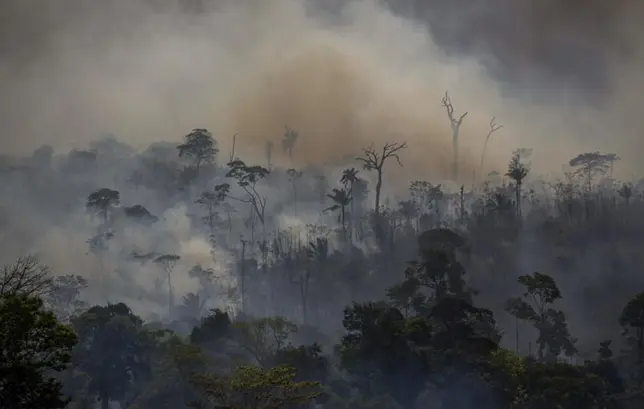The question of whether the Amazon is a source or a sink of carbon for the global atmosphere has been the subject of intense debate. Although there are divergent opinions, it is undisputed that deforestation and biomass burning have played a significant role in the release of carbon in the region.
Over the period 1989 to 1998, average carbon emissions from deforestation and biomass burning in the Brazilian Amazon were estimated to be around 200 ± 100 megatons per year. These emissions were the result of the relatively rapid decomposition of the remaining biomass after the fires, as well as the organic matter in the soil, together with the removal of wood. Importantly, these emissions represent approximately 10% to 15% of global emissions from land-use change, which were estimated to be 1.7 ± 1.1 gigatons of carbon per year.
However, it is worth noting that these estimates may underestimate actual emissions, since they do not take into account the burning of standing forests, such as the case of the massive forest fire in Roraima in the first months of 1998. generally fire resistant due to high humidity, gradual degradation and fragmentation of the forest over the past few decades has made it more susceptible to fire. Solar radiation can penetrate more easily into fragmented areas, leading to dryness of the wood and increasing its flammability. This situation is aggravated in regions of the Amazon subject to prolonged droughts, such as those caused by the El Niño phenomenon in the north and east of the region.
An alarming fact is that, if the entire Brazilian Amazon forest were converted, it is estimated that around 77 gigatons of carbon would be released into the atmosphere. This number increases to more than 100 gigatons of carbon considering the entire Amazon. These estimates demonstrate the catastrophic potential of deforestation in terms of carbon emissions and its significant contribution to increasing levels of greenhouse gases in the atmosphere.
The recent study highlighted by the World Meteorological Organization (WMO) reveals a worrying change in the pattern of the Amazon rainforest. According to the survey, the Amazon is emitting more carbon dioxide (CO2) than it is capable of absorbing, indicating a drop in the carbon capture capacity of this important region.
The researchers carried out measurements of carbon dioxide and carbon monoxide fluxes at four different points in the Amazon, over approximately eight years, between 2010 and 2018. These measurements were obtained through approximately 600 flights across the region, providing a broad and comprehensive analysis of the situation. The results revealed that the Amazon rainforest is releasing more carbon into the atmosphere than is being absorbed, signaling a worrying shift in its role as a major carbon sink.
The WMO points out that this drop in carbon capture is a direct consequence of deforestation and climate change. The Amazon has been suffering from high rates of deforestation for decades, mainly caused by the expansion of agriculture, mining and uncontrolled logging. Vegetation loss and forest degradation reduce carbon absorption capacity, increasing greenhouse gas emissions. In addition, changes in temperatures and rainfall patterns in the region have negative impacts on vegetation, creating a more hostile environment and contributing to increased emissions.
This change in the behavior of the Amazon forest is alarming, as tropical forests have historically been considered important carbon sinks, helping to mitigate climate change. However, recent discoveries indicate that the Amazon is becoming an additional source of CO2 for the atmosphere.
Amazon: Carbon Source or Sink? The Search for Answers
The Arc of Deforestation is a vast swath of primary tropical forest located in the Brazilian Amazon region. This area has been progressively invaded by roads, dams, mining companies and transmission lines, in addition to being transformed into secondary forest, cattle farms, soybean plantations and other crops.
This phenomenon is the result of a process of human occupation and exploitation that has taken place over decades in the Amazon. The construction of infrastructures, agricultural expansion and the search for natural resources have led to the degradation and conversion of primary forests into areas for human use.
Deforestation in this region has significant impacts on the Amazon ecosystem and across the planet. The primary forests of the Amazon are known for their rich biodiversity and carbon sequestration capacity. However, when these forests are degraded or converted into areas for human use, not only are valuable species lost, but also the ability to absorb and store large amounts of carbon dioxide, an important greenhouse gas.
The expansion of the Arc of Deforestation in the Brazilian Amazon raises environmental and socioeconomic concerns. The loss of primary forests results in reduced biodiversity, compromised ecosystem services such as climate regulation and water purification, and increased greenhouse gas emissions.
In addition, the conversion of forests into areas of intensive agriculture and livestock is also associated with social issues, such as the displacement of traditional and indigenous communities, land conflicts and problems related to exploitation and labor rights.
The release of data by the System of Estimates of Emissions and Removals of Greenhouse Gases (SEEG) reveals an alarming reality: among the 10 Brazilian municipalities that emit the most greenhouse gases, responsible for global warming, eight are located in the Amazon region, five of them in the state of Pará. This estimate is based on the year 2019, the most recent information available for the country.
This finding is extremely worrying, as the Amazon is known as a region of immense environmental importance, being considered the “lung of the world”. However, these data demonstrate that the impacts of human activities in the region are resulting in high emissions of greenhouse gases, significantly contributing to global warming and climate change.
The state of Pará, in particular, stands out as a critical area, with five municipalities present in this worrying ranking. This reflects the intense economic activity in the region, including deforestation, agriculture, livestock and uncontrolled mining. Deforestation is one of the main causes of these emissions, as it results in the release of carbon stored in the trees and forest floor.
When a tree dies, either by natural decomposition or by burning, it emits carbon in the form of carbon dioxide (CO2). Furthermore, under anaerobic conditions, that is, without oxygen, part of this carbon can be transformed into methane (CH4), a gas with even greater global warming potential. Nitrous oxide (N2O) is also released during the decomposition process.
SEEG data use the ton of CO2 as a unit of measurement, but it is important to highlight that total emissions are not limited to CO2 only. Methane and nitrous oxide also contribute significantly to the climate impact of these emissions. For every tonne of CO2 emitted, the methane equivalent is 25 tonnes of CO2 and the nitrous oxide equivalent is 270 tonnes of CO2.
The municipalities in the Amazon have extremely high rates of emissions per inhabitant due to the intense deforestation in the region. Although these locations have few inhabitants, the rate of deforestation is significant, resulting in a large amount of carbon released into the atmosphere. A worrying example is the municipality of Novo Progresso, which registered the so-called “Fire Day” in 2019, a coordinated action by farmers, businessmen and rural producers to burn protected areas near the BR-163. This municipality has the highest per capita rate of emissions in the country, with about 580 tons of CO2 per year. In comparison, the annual global average is approximately 7 tonnes of CO2e per inhabitant.
A study carried out in Zona Bragantina, in Pará, revealed that the secondary forest of the Brazilian Amazon absorbs only twice the carbon rate of the primary forest, while in other parts of the world this rate can be up to 11 times higher. This finding raises concerns about the ability of tropical forests to regenerate and their contributions to climate change mitigation.
Zona Bragantina is a region that has been used for agricultural production for centuries, resulting in the almost complete absence of primary forests. The researchers emphasize that it is unlikely that these degraded forests will be able to return to their original levels of carbon sequestration and biodiversity in a politically significant period of time. This means that the carbon absorption capacity of secondary forests may be limited and not live up to expectations.
These results have important implications for both scientific understanding and reforestation policy. The researchers highlight the need for greater caution when estimating the carbon absorption capacity of regenerated tropical forests. This capacity varies according to several factors, and the overvaluation of these estimates can lead to unrealistic expectations regarding climate change mitigation efforts.
Furthermore, the findings cast doubt on Brazil's plan to reforest regions as part of its Paris Agreement commitments. The country has committed to restoring 12 million hectares of forest by 2030. However, the study suggests that the actual carbon sequestration value of these new secondary forests, including tree plantations, may be much lower than expected.
The cultivation of trees as a form of regeneration has been considered by the United States as an important strategy. However, the preservation of Brazilian forests to meet the Paris Agreement carbon targets is a crucial issue that has significant implications for the region's biodiversity. The search for carbon storage solutions, such as tree planting, may have negative consequences for species diversity in the Brazilian rainforest.
It is important to highlight that planting trees in itself is not a negative practice, especially when carried out in a sustainable manner and considering the diversity of native species. However, when there is an excessive focus on certain species, such as palm oil and eucalyptus, to the detriment of the natural diversity of forests, a drastic decrease in local biodiversity can occur.
Palm oil, for example, is often grown in monoculture plantations, which involves clearing natural forests to make way for vast areas dedicated solely to this crop. This leads to habitat loss for many native species, including plants, animals and insects, which depend on a variety of habitats to survive.
Likewise, eucalyptus is an exotic species that can be planted on a large scale for the production of wood and cellulose. This practice can also have negative impacts on local biodiversity, as eucalyptus monocultures generally do not provide a suitable environment for many native species.
Species diversity is critical to the health and resilience of ecosystems. Interactions between different species play important roles in maintaining nutrient cycles, pollination of plants, pest and disease control, and many other essential ecological processes. Biodiversity loss can compromise the stability of ecosystems and their ability to adapt to environmental changes.
Furthermore, the regrowth capacity and carbon storage of these forests can vary widely from place to place, depending on soil properties, climatic conditions and land use history, among other factors. Much of the information on the regrowth of tropical secondary forests comes from studies carried out in places with greater vegetation cover than the Bragantina Zone and with less intensity of land use over time, which creates more favorable conditions for the growth of trees and biodiversity recovery. The new study offers a clearer view of how forests recover under less favorable conditions.
The results of this study highlight that even the Amazon rainforest, which is considered very resistant to external disturbances, can take more than a century to recover its original carbon stock and level of biodiversity. Catarina Jacovac, secondary forest researcher at Wageningen University & Research, highlights the importance of preserving old-growth forests to ensure the resilience of the Amazon ecosystem as a whole.
These findings have significant implications for climate change mitigation strategies and reforestation efforts.
In recent years, intense droughts related to the El Niño phenomenon have negatively impacted the recovery of secondary forests. The researchers observed an increase of 0.1°C per decade in the temperature of the Zona Bragantina, along with a reduction in plant growth during the driest periods.
The link between droughts and climate surprised researchers. During periods of drought, they recorded less carbon uptake by secondary forests, which is an alarming finding, especially considering that large areas of the Amazon's Arc of Deforestation have been experiencing long periods of drought and becoming hotter.
These results underscore the importance of protecting primary forests, which play a crucial role as providers of seeds for the regeneration of secondary forests and as regulators of the regional climate. Jos Barlow, co-author of the study and researcher at Lancaster University, points out that it is essential to ensure the protection of primary forests before considering the role of secondary forests in mitigating climate change.
Emissions from deforestation and fires in the Amazon are a significant concern in terms of the region's carbon balance. While it is true that around 86% of global emissions come from burning fossil fuels and only 14% result from changes in land use and forestry, it is important to recognize that human activities in the Amazon have a considerable impact on carbon emissions.
Deforestation is responsible for a substantial portion of these emissions. When trees are cut and burned, the carbon stored in them is released into the atmosphere in the form of carbon dioxide (CO2), contributing to increased concentrations of this greenhouse gas. Deforestation in the Amazon has been mainly driven by agricultural expansion, livestock and illegal logging activities.
Fires are also a significant source of emissions in the region. During the dry season, the occurrence of forest fires is common, many of them intentional to clear deforested areas. These fires release large amounts of CO2 and other polluting gases into the atmosphere, contributing to the region's total emissions.
One example is the city of Santarém, which recorded a loss of 37% of its forest cover. This region experienced a decrease of 9% in average annual rainfall. However, during the months of August, September and October, the reduction was even more significant, reaching 34%. That means there was a third less rain in those months over a 40-year period. In addition, the temperature also increased by 1.9ºC in this northeastern region of the Amazon.
In the southeastern region of the forest, which suffered a 28% loss of its forest cover, the impacts are even more pronounced. During the months of August and September, there was a 24% reduction in precipitation. In addition, the temperature increased considerably, with an average increase of 2.5°C. If you consider only the months of August and September, the increase reaches 3.1ºC over 40 years.
In fact, during the period from 2010 to 2018, the Brazilian Amazon was responsible for releasing an alarming amount of carbon dioxide into the atmosphere due to fires. It is estimated that around 1.06 billion tons of CO2 were emitted per year as a result of these fires.
However, the region's carbon balance reveals a worrying situation. Only 18% of emissions from fires were absorbed by the forest, resulting in a final balance of 0.87 billion tons of CO2 emitted annually.
These numbers indicate that the ability of the Amazon rainforest to act as a carbon sink is severely compromised.
Recent research used satellite datasets to analyze the effects of human activities on forests in the Amazon, Central Africa and Borneo, as well as their potential for regeneration and carbon storage. The results revealed significant differences between these regions.
The study found that in Borneo, human disturbance, especially intensive logging of economically valuable trees, resulted in the greatest carbon reductions in degraded forests. This indicates that deforestation and logging play an important role in carbon loss in this region.
Surprisingly, the researchers also found that Borneo has the capacity to accumulate carbon at a rate about 50% faster than the Amazon and Central Africa. This accumulation of carbon is influenced by Borneo's unique climatic and environmental conditions.
The models developed in this research can be valuable tools for scientists and policy makers, as they provide information on the potential for carbon storage in secondary and degraded forests, provided they are protected and restored. These models help to understand the resilience of forests and highlight the importance of forest conservation and recovery policies to mitigate climate change and preserve biodiversity.
The results of this research underscore the need to address human activities that negatively impact forests, such as deforestation and unsustainable logging. At the same time, they highlight the importance of encouraging forest restoration efforts and protection of degraded areas, in order to promote natural regeneration and carbon sequestration. These measures play a key role in mitigating climate change and conserving forest ecosystems on a global scale.
It is important to note that the recovery of the Amazon's ability to remove carbon from the atmosphere can be achieved if effective measures are implemented to control fires and deforestation. If these restrictions are put in place next year, the region could recover and return to acting as a carbon sink. Reforestation plays a key role in this process, helping to increase the Amazon's carbon absorbing capacity by planting trees and restoring forest ecosystems.
Recovery actions are being observed mainly in the eastern part of the Amazon, where deforestation has averaged 30% of the area. Studies reveal that, when deforestation reaches this level, the Amazon starts to emit more carbon than it absorbs. If fires in the Amazon region are stopped, the forest would have the capacity to remove 0.19 billion tons of carbon from the atmosphere annually. This indicates that the Amazon could act as a significant carbon sink if fires are controlled.
However, it is important to note that full recovery will take time. Consistent measures will need to be taken over the years, including restoring ecosystems and increasing forest cover through continuous tree planting.
In addition to stopping deforestation and fires, it is also crucial to address the underlying causes of these practices, such as agricultural expansion, intensive livestock farming and illegal logging. It is fundamental to promote sustainable practices, such as agroforestry, and to strengthen environmental protection policies. The active participation of local communities and indigenous peoples is essential as they play a significant role in the conservation of natural resources.
The recovery of the Amazon is not only a regional challenge, but also a global concern. The Amazon rainforest plays a crucial role in regulating the climate, preserving biodiversity and sustaining water resources.




